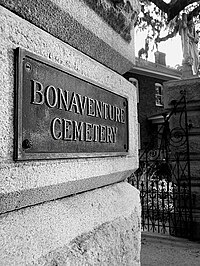Bonaventure Cemetery
 |
|
| Details | |
|---|---|
| Established | 1846 |
| Location | 330 Bonaventure Road Savannah, Georgia, United States |
| Coordinates | 32°2′38″N 81°2′44″W / 32.04389°N 81.04556°WCoordinates: 32°2′38″N 81°2′44″W / 32.04389°N 81.04556°W |
| Type | Public municipal |
| Owned by | City of Savannah |
| Size | 160-acre (647,000 m2) |
| Find a Grave | Bonaventure Cemetery |
|
Bonaventure Cemetery
|
|
| Architect | Urban, Henry; et al. |
| NRHP Reference # | 01000035 |
| Added to NRHP | February 2, 2001 |
Bonaventure Cemetery is a public cemetery located on a scenic bluff of the Wilmington River, east of Savannah, Georgia. The cemetery became famous when it was featured in the 1994 novel Midnight in the Garden of Good and Evil by John Berendt, and in the movie, directed by Clint Eastwood, based on the book. It is the largest of the city's municipal cemeteries, containing nearly 160 acres (0.65 km2).
The entrance to the cemetery is located at 330 Bonaventure Road. Immediately inside the gates is the large and ornate "Gaston's Tomb".
The cemetery is located on the site of a plantation originally owned by John Mullryne. On March 10, 1846, Commodore Josiah Tattnall, Jr., sold the 600-acre (2.4 km2) Bonaventure Plantation and its private cemetery to Peter Wiltberger. Major William H. Wiltberger, the son of Peter, formed the Evergreen Cemetery Company on June 12, 1868. Evergreen Cemetery Company was purchased by the City of Savannah on July 7, 1907, making the cemetery public and changing the name to Bonaventure Cemetery.
In 1867 John Muir began his Thousand Mile Walk to Florida and the Gulf. In October he sojourned for six days and nights in the Bonaventure cemetery, sleeping upon graves overnight, this being the safest and cheapest accommodation that he could find while he waited for money to be expressed from home. He found the cemetery even then breathtakingly beautiful and inspiring and wrote a lengthy chapter upon it, "Camping in the Tombs."
"Part of the grounds was cultivated and planted with live-oak (Quercus virginiana), about a hundred years ago, by a wealthy gentleman who had his country residence here But much the greater part is undisturbed. Even those spots which are disordered by art, Nature is ever at work to reclaim, and to make them look as if the foot of man had never known them. Only a small plot of ground is occupied with graves and the old mansion is in ruins.
The most conspicuous glory of Bonaventure is its noble avenue of live-oaks. They are the most magnificent planted trees I have ever seen, about fifty feet high and perhaps three or four feet in diameter, with broad spreading leafy heads. The main branches reach out horizontally until they come together over the driveway, embowering it throughout its entire length, while each branch is adorned like a garden with ferns, flowers, grasses, and dwarf palmettos.
...
Wikipedia


